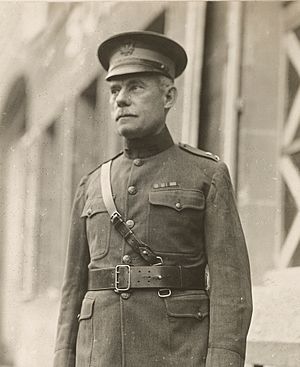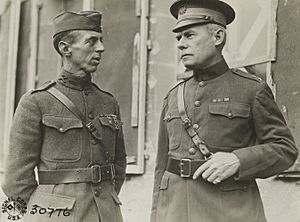James McRae (United States Army officer) facts for kids
Quick facts for kids
James Henry McRae
|
|
|---|---|

James McRae in Chatel-Chéhéry, France, October 25, 1918.
|
|
| Born | December 24, 1863 Lumber City, Georgia, United States |
| Died | May 1, 1940 (aged 76) Berkeley, California, United States |
| Buried |
Arlington National Cemetery, Virginia, United States
|
| Allegiance | |
| Service/ |
|
| Years of service | 1886−1927 |
| Rank | |
| Service number | 0-52 |
| Unit | |
| Commands held | 158th Depot Brigade 9th Brigade 78th Division 5th Corps Area Philippine Department 9th Corps Area 2nd Corps Area |
| Battles/wars | Spanish–American War Philippine–American War World War I |
| Awards | Army Distinguished Service Medal Silver Star (2) Companion of the Order of the Bath (United Kingdom) Commander of the Legion of Honor (France) Croix de Guerre (France) |
James Henry McRae (born December 24, 1863 – died May 1, 1940) was a high-ranking officer in the United States Army. He served in several important wars and held many leadership roles during his long military career. He became a Major General, which is a very senior rank in the army.
Contents
Early Life and Education
James Henry McRae was born on December 24, 1863, in Lumber City, Georgia. His parents were Daniel F. McRae and Marion McRae.
He attended the United States Military Academy, often called West Point. This is a famous school where future army officers are trained. He graduated in 1886. Many of his classmates also became generals, just like him.
A Long Military Career
After graduating, McRae joined the infantry, which is the part of the army that fights on foot. For two years, from 1886 to 1888, he served on the frontier, helping to keep peace in new territories.
Serving in Different Wars
McRae fought in several major conflicts. During the Spanish–American War, he took part in the Battle of El Caney in Cuba. He also worked in the Sanitary Corps, which helped with health and hygiene for soldiers. For his actions, he received his first Silver Star medal.
He earned a second Silver Star during the Philippine–American War. This medal is given for bravery in battle.
Leading Divisions and Corps
From 1905 to 1908, McRae worked on the General Staff, helping to plan army operations. In 1911, he completed his studies at the United States Army War College, a school for senior officers.
When World War I began, McRae was promoted to brigadier general in August 1917. He commanded the 158th Depot Brigade and later the 9th Brigade. In April 1918, he became a major general. He then led the 78th Division of the American Expeditionary Forces (AEF) on the Western Front in France. He stayed in command until June 1919, after the war ended.
After World War I, McRae continued to serve in important roles. He helped manage army personnel from 1921 to 1922. He also commanded large army areas, known as Corps Areas, including the 5th, 9th, and 2nd Corps Areas. He even briefly commanded the Philippine Division and served in the Philippine Department.
McRae retired from the army on December 24, 1927, when he reached the mandatory retirement age of 64.
Family and Later Years
On December 14, 1887, James McRae married Florence Stouch. They had three children: Donald M. McRae, Dorothy McRae, and Mildred McRae. After Florence passed away, he remarried Helen "Nellie" Burgar Stouch on February 24, 1926.
After retiring from the army, James McRae lived in Berkeley, California. He passed away on May 1, 1940. He is buried in Arlington National Cemetery, a special place where many American heroes are laid to rest.


